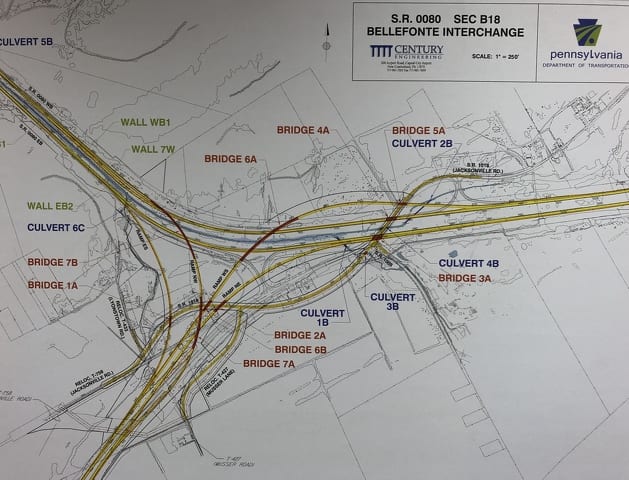STATE COLLEGE — After being discussed for what seems like ages, the proposed high-speed interchange at Interstates 80 and 99 is kicking into gear with a $34 million federal grant received by PennDOT. On Feb. 26, the agency gave a presentation on the project at the Patton Township building.
The interchange will improve traffic patterns as drivers use I-99 and I-80 to come into the region, but will change local traffic as state Route 26 will not have access to I-80 when the project is complete. Access to SR 26 (Jacksonville Road) from I-80 will come from a new exit that will be built two miles to the east of the current exit, said PennDOT Assistant District Executive of Design Thomas Zurat.
The $34 million will go toward building this new local access interchange to SR 26. PennDOT plans to open bids for the project on April 23, 2020, and anticipates finishing it in December 2021.
This part of the project includes building a connector road from SR 26 to the on- and off-ramps of I-80.
After the new local access interchange is complete, the next steps of the project will be to go out to bid in March of 2022. The next steps include making improvements to Jacksonville Road between the new I-80 exit as it heads south back toward I-80, bridge improvements to the eastbound and westbound structures over Hubler Ridge Road and Sand Ridge Road, and construction of the high-speed interchange for I-80 and I-99.
PennDOT expects the Jacksonville Road improvement to be complete by July 2023 and the bridge improvement to be complete by December 2023.
The Jacksonville Road improvements will be made to handle the increased traffic that will come from the new local access point.
“We are going to do a little bit of widening, put in wider shoulders and pave the roadway. And it you ever ride down the road, there is a lot of up and down and we are going to smooth out those over verticals and such,” said Zurat.
The high-speed interchange work looks to be completed by December 2025.
“There will be no connection to 26 when we are done, so there will be no local access,” Zurat said. “This will be a high-speed connection between the two interstates. So what happens because of that, to the east of this interchange we are building a new local interchange for people to get on and off of 26. This will get bid and built first — the local interchange. This is about two or three miles toward Howard down 26, so you will be able to get on and off 80 and hook over toward 26 or what will be the new 1018 and take you back toward the quarry, which will come in here on Jacksonville Road and tie you underneath the interstate and keep going down Jacksonville toward Bellefonte.”
This leaves options for people looking to get to Jacksonville Road from heading north on I-99 to get off at the 550 interchange or get on I-80 east for two miles and get off at the new interchange.
An aspect of the project designed to improve safety looks to get started by the end of this year, with improvements made to the current SR 26/I-80 westbound ramp that has long been an issue with backups as motorists look to get off I-80 to head to Penn State, especially during a football weekend.
This past year, a traffic light with a sensor was installed to help move traffic along. PennDOT plans to push back the embankment on the east side of 26 as people approach the traffic light to make it more visible and extend the exit ramp 400 feet coming off of I-80 westbound onto 26 to “accommodate a little more stacking,” said Zurat. PennDOT is also going to add more sensors to allow the ramp to clear more smoothly during high-traffic times.
The high-speed interchange will also help further the plan to extend I-99 north toward the New York border.
“It opens up the extension of I-99, but the feds are still looking,” said Zurat. “Probably the biggest concern for 99 right now is the section going up to Williamsport. Once you get up into Lock Haven and up into Jersey Shore, it narrows down with a lot of houses and businesses for just a short section and then it opens back up to four lanes. That is kind of the restriction right now. It wouldn’t take us much to connect 80 to the Lock Haven bypass; that lower part is farm fields and you could do that. It’s the piece north of that that would be a little more difficult.”
Zurat added that I-99 currently stops at Musser Lane, a half-mile before I-80, but the new interchange will allow that last half mile to be considered I-99.
The overall project will cost about $200 million, he said.
Penn State is a test bed for automated vehicles, Zurat said, and part of the grant is to lay down a fiber network to allow the interchange to be part of the testing.
“So, that will be neat to see what that brings to the area,” said Zurat. “But the big thing is to move the freight and the people and having a more reliable system will make it much better for the users.”




